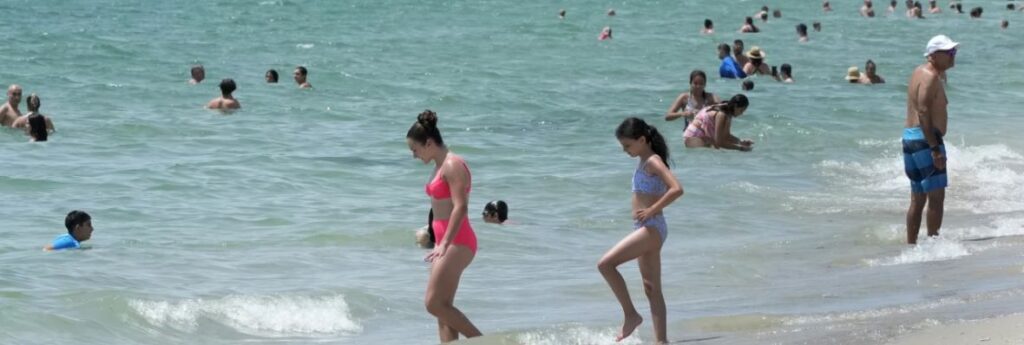Record global ocean heating has invaded Florida with a vengeance. Water temperatures in the mid-90s (mid-30s Celsius) are threatening delicate coral reefs, depriving swimmers of cooling dips, and exacerbating the Sunshine State’s already oppressive summer weather. Forecasters are warning of temperatures that with humidity will feel like 110 degrees (43 C) by week’s end.
If that’s not enough, Florida is about to get a dose of dust from Africa’s Saharan desert that’s likely to hurt air quality, even if it typically creates exquisite sunsets.
The globe is coming off a week of heat not seen in modern measurements, the World Meteorological Organization said Monday. Global sea surface temperatures have been record high since April and the North Atlantic has been off-the-charts hot since mid-March, meteorologists report as climate change is linked to more extreme and deadly events.
Now it’s Florida’s turn.
Water temperature near Johnson Key came close to 97 degrees (36.1 C) Monday evening, according to a National Oceanic and Atmospheric Administration buoy. Another buoy had a reading close to 95 (35 C) near Vaca Key a day earlier. These are about 5 degrees warmer than normal this time of year, meteorologists said.
“That’s incredible,” said National Weather Service meteorologist Andrew Orrison. “The water is so warm you really can’t cool off.”
While the 95- and 96-degree readings were in shallow waters, “the water temperatures are 90 to 93 degrees Fahrenheit around much of Florida, which is extremely warm,” said University of Miami hurricane researcher Brian McNoldy. He said his 95-degree pool doesn’t cool him – it just leaves him wet.
Water temperatures across the Gulf of Mexico and Southwest Atlantic are 4 to 5 degrees (2 to 3 C) warmer than normal, Orrison said. Because the water is so warm, the air in Florida gets more humid and “that’s making things tougher or more oppressive for people who are going to be out and about,” he said.
The heat dome that baked Texas and Mexico for much of the early summer has oozed its way to Florida with sunshine, little to no cooling clouds or rain, but humidity worsened by the hot oceans, Orrison and McNoldy said.
Not only will it stick around for a while as weather patterns seem stuck – a sign of climate change, some scientists contend – “it may actually tend to get a little bit worse,” Orrison said, with extra heat and humidity that has NOAA forecasting a heat index around 110 by weekend.
It could be worse. Air temperatures of 110 are forecast for the US Southwest, including Arizona, New Mexico and southeast California, Orrison said. Death Valley should see highs of 120 to 125 by the end of the week, and possibly a highly unusual 130.
At Hollywood Beach, south of Fort Lauderdale, Monday’s 91 degrees were about average and Glenn Stoutt said the breeze made him fine to do lunges with a 6.8-kg weighted ball and calisthenics – though he wore shoes on the blazing sand.
“It’s funny to watch the new people and the tourists get about halfway out and realize their feet are getting scorched,” Stoutt said. “They start running, but it doesn’t matter how fast you run, you need to get them in the water.”
Scientists say a new El Nino is part of the reason for the current heat, along with ever-increasing warming from the burning of coal, oil, and natural gas.
Then there’s that Sahara dust.
With little rain to keep the soil grounded, it’s common this time of year for plumes of dust particles from the Sahara Desert to blow across the Atlantic on upper-level winds. It takes strong winds to push them all the way to Florida so it doesn’t happen often.
One plume settled over South Florida on Monday, and the next plume was expected later in the week, said Sammy Hadi, a meteorologist for the National Weather Service in Miami. The plumes typically stay two to three days and dry the atmosphere so there are fewer of the afternoon rains that are typical for Florida summers.
One plus: sunlight bouncing off those dust particles produces more vivid sunrises and sunsets.
“In general, it makes the sunrises and sunsets more vibrant and beautiful,” Hadi said.

